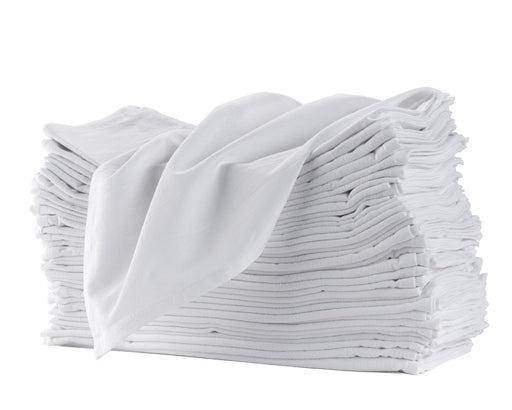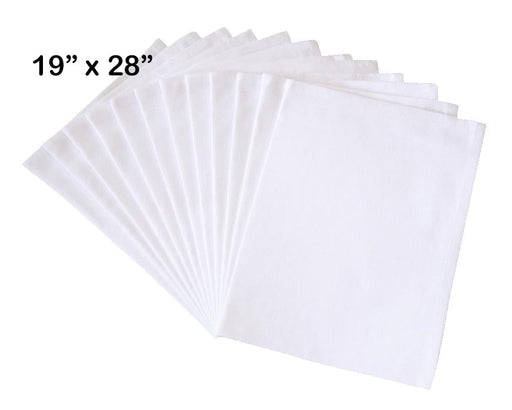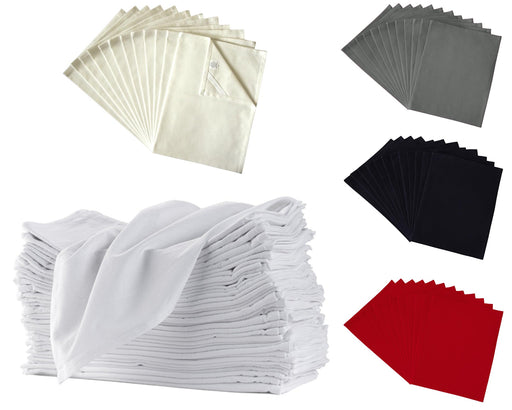Continental U.S. only.
Continental U.S. only.
Paris is not just a city for lovers or the place to find the latest clothing styles. It is also the city to admire for chic kitchen trends. The décor of Paris kitchens prove that less space is more. If you love to cook or enjoy interior decorating, beautifying a kitchen Parisian style will give it the perfect atmosphere. From spices and accessories to appliances and design concepts, here are ten charming ideas that will make your kitchen sophistiqué et très Parisien.

Flour sack towels might sound like something used to carry flour, but they’re actually smooth, white cotton towels about the size of a hand towel. These towels are known for being lint-free, making them perfect for a variety of kitchen tasks. The name derives from the 18th century when frugal and resourceful housewives would cut up empty flour sacks and embroider them to use as kitchen towels. Vintage and stylish, they are making a comeback in modern kitchens.
SHOP FLOUR SACK TOWELS NOW
Flour sack towels have many uses and are great kitchen accessories because they are durable, extremely absorbent, and safe to use around food. Parisians often use these tea towels as decorative cloth napkins or to replace traditional kitchen dishcloths. Flour sack towels blend with any kitchen décor because of their simplistic appearance and design. Many Parisians customize their flour sack towels with embroidery patterns and designs.

Most kitchens in the United States contain large appliances, one of which is the stove. However, in France, Parisians are all about conserving space in their kitchens since that room is quite cramped. Most Parisian kitchens are equipped with induction cooktops. This type of cooking range is half the size of a full-sized stove and fits neatly along the countertop area. An induction cooktop is more attractive than a traditional stove because the cooktop is made of a glass ceramic finish. Cleaning up after cooking is easier because all you have to do is wipe the cooktop down with a soft rag. Also, induction cooktops are safer to cook on than traditional stovetops. With induction technology, there is no flame or electric current to burn you or food that drops on a range plate since the pot is heated, not the cooking range.

Parisians often eat a baguette with every meal, so it is not uncommon to see at least one fresh baguette from the local boulangerie (bakery) on the table or countertop waiting to be consumed. For Americans concerned about the carbs, consuming so much bread may seem like a bad idea. However, French baguettes are nothing like the processed bread that Americans consume. There is even a French law, Le Décret Pain, that requires for all baguettes to be baked in the same healthy way with natural ingredients: flour, yeast, salt, and water. Baguettes are so important to the Parisian dining experience that there is an etiquette to buying, serving, and eating a good baguette.

Wooden wine racks are useful, but they take up too much counter space. To recreate the ambiance of a Parisian restaurant or wine bar in your kitchen, replace your wooden wine rack with an elegant wine carafe with stackable glasses. A traditional wine carafe does not include a stopper like a wine decanter. Parisians prefer to let their wines oxygenise and aerate to bring out the flavor. Carafes are designed with a long body and small base to hold large volumes of liquid, so they can also be used to hold water, juice, or another type of alcoholic beverage.

Give your kitchen table an upgraded look by replacing its chairs with a set of Parisian bistro dining chairs. Charming and comfortably shaped, bistro chairs are crafted to resemble the seats outside of Parisian cafes. The design of this chair is so classic that manufacturers have not changed or improved upon the design since the chair first hit the market in the 1800s. The café bistro chair has become one of the most purchased types of chairs around the world because as the chair matures, it conforms to a wonderfully comfortable piece of furniture.

Drinking coffee is a popular pastime in Paris. Locals prefer to drink their cafe au lait or tea out of bowls, not mugs or petite porcelain cups. Using a coffee bowl serves two purposes. Locals love to dip pieces of leftover baguette topped with butter and jam into their brews as a breakfast treat. Also, the size of the bowl helps the hot beverage cool down faster. While a bowl seems cumbersome to drink out of, Parisians are experts. They just hold the bowl with two hands, bring it up to their lips, and sip.

Parisians are born with a flair for decorating, and they enjoy when their guests comment on decorative pieces placed throughout the house. Kitchen walls are often painted white to maximize the amount of natural light. However, a stark white wall throughout the entire kitchen is rarely seen because Parisians appreciate a touch of color. To cozy up the room, it is not uncommon to see one wall painted a bold hue. Parisians also create accent walls in their kitchens and adorn them with vintage frames, eclectic pieces of art, or family pictures.

Flower shops are a common sight in Paris. Nothing makes a Parisian kitchen more inviting than a fresh bouquet of flowers from a local marché aux fleurs. As with everything done in Paris, there is an etiquette to picking out the type of flower bouquet that sits atop the kitchen table, countertop, or window sill. Parisians typically choose flowers that are in season or that complement what is served for breakfast, lunch, or dinner. As a rule of thumb, a bouquet should not contain more than three varieties of flowers, and the range of colors should be tonal. Lastly, a bit of foliage adds a nice touch.

Paris has some of the best fromageries in France. These cheese shops offer cheeses for every occasion and every meal. Locals are serious about when to serve their favorite cheeses and what cheeses to serve with certain foods and wines. Cheese that is wrapped up in the refrigerator is not ready to be served. Cheese should be served at room temperature to bring out the delicious flavors. It is a common practice to plate the cheese and set it out on the table or countertop, so it can breathe just like wines. There should always be a minimum of three varieties to serve guests: a hard cheese, soft cheese, and a blue or goat cheese. Cheese is never served as an appetizer and always before dessert in that most French cheeses are pungent to the palate.

Butter is just as important to a Parisian’s diet as is cheese, wine, and crispy baguettes. Paris kitchens are known to stock two types of butter for eating and cooking: sweet cream and salted butter. Parisians put “a dab” of butter in practically every dish. It is the secret ingredient to creamy sauces, the favorite spread for croissants, and the yummy fat in desserts. The average person in Paris consumes 60 percent more butter than the average American.
Capturing the Parisian design style starts with making the most out of a little bit of space. Also, you do not have to spend a lot of money. To decorate your kitchen like a native from Paris, focus on fusing the old with the new and purchase fresh foods to create your delicious meals. A touch of Parisian panache in your American kitchen will warm your heart and impress your guests. To start your kitchen makeover today, just follow the suggested tips and remember to never compromise on quality.

If you need red, gray, blue or black color please click here. ★ Multipurpose, available white or natural colors (unbleached), matching, wholesale ...
View full details
Custom Printed Flour Sack Towels ★ Current Production Time: 3–4 Weeks WHOLESALE | RESELLERS | DESIGNERS ✅ Everyone is welcome to order! If you'r...
View full details
100% Cotton, comes in white (bleached) and natural (unbleached) color A uniform 19" x 28" rectangle, 130 thread count, flour sack napkins hemmed...
View full details
100% Cotton A uniform 27" x 27" square, 130 thread count, 3 oz each heavyweight flour sack dish towels and hemmed on all sides A corner loop for...
View full details
Attention Re-sellers, Wholesalers, and Designers: If you need to order more than 100 pieces, please contact us for our special wholesale pri...
View full details